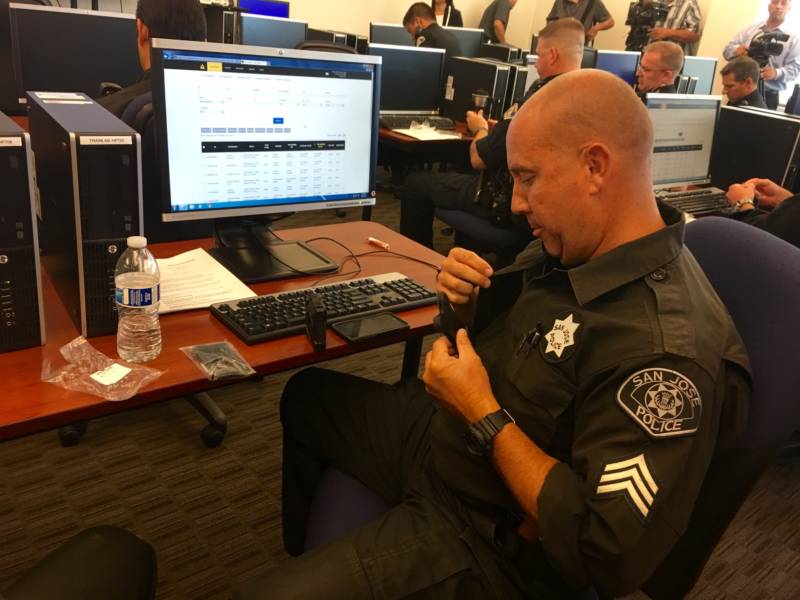"Very historical moment for San Jose," said Eddie Garcia, San Jose police chief. "Body-worn cameras are here."
The San Jose Police Department becomes part of the country's body-worn camera trend, as police departments and the nation reel from questionable officer-involved shootings of African-American men and the fatal shootings of five Dallas police officers July 7 and three Baton Rouge police officers Sunday.
"It almost appears that we're at a time of national crisis," said Walter Katz, the independent police auditor for San Jose. "It feels like we're at a fork in the road, at either fixing police-community relations or going to a very bad place."
In San Jose's Washington neighborhood -- an area patrolled by Pritchard because of longtime gang activity -- street-savvy Miguel Bucio agrees the timing is good. The 19-year-old said he's a gang member and he wants the cameras rolling as much as possible because he often gets stopped and questioned by police.
"I think it's a good idea for them to have cameras because of everything that's been happening," said Bucio. "They assume we have guns and stuff. I think it's good they can see we don't have nothing on us."
One of the key parts of the San Jose police officers' training focuses on when to turn the new $400 cameras on and off. Garcia said the policy is direct and comprehensive.
"If they're conducting enforcement, they'll be rolling," said Garcia. "If they performed a car or pedestrian stop, that should be recorded."
To make sure the cameras are activated when they should be, supervisors will be conducting random audits to make sure they are recording, said Lt. Elle Washburn of SJPD's body-worn camera administrative unit.
"We tell our officers you're not going to get in trouble for the videos you have. What's going to get you into trouble is when you are supposed to have a video and don't," said Washburn. "And they're learning that through training."
In addition, Garcia said that when officers are dispatched on calls for service they are logged.
"Well, if they went out on a call for service -- if they performed a car or pedestrian stop -- that stop should be recorded," said Garcia. "So there's going to be a way that we're going to be able to tell that as well when you cross-reference those things."
Washburn said it's also impossible to alter the body-camera tape.
"There's no way to eliminate it or delete it or alter it," said Washburn. "There's audit trails, there's security measures built into the system."
As independent police auditor, Katz said one of the most controversial issues involves access to the tapes.
"Officers for the San Jose Police Department will be able to see the footage before writing their reports, with the exception of officer-involved shootings and other highly critical incidents like that," said Katz. "I'm not really happy with that."
Katz said he will have access to the video but the public will not right away, if at all, because the California Public Records Act restricts that during an investigation.
Washburn said the Police Department is in constant discussion and analysis with the Santa Clara County District Attorney's Office and the city attorney's office about how and when that information will be released.
"I recognize we're spending a lot of public money on body cameras, but just because it's not going to be immediately released to the public or end up on the 10 o'clock news does not mean it's not without value," said Washburn. "It [the video] doesn't go away."
Santa Clara County District Attorney Jeff Rosen said his office may release the video when an investigation is over, but also may decide not to.
"If we're not filing criminal charges but then we release all of these police reports or video footage, well, aren't we smearing the individual involved then?" said Rosen.
He has been meeting with all of the police chiefs in Santa Clara County for the last three years developing the guidelines for body cameras.
"The California Public Records Act is different than the public records acts in other states," said Rosen. "And there's an exception in the California Public Records Act for investigations. And so how that's interpreted will determine, to an extent, how body-worn camera footage will be made public."
Rosen said there are different scenarios. He recently released the body-camera footage of an officer-involved-shooting in Palo Alto following the investigation. He said a public report explained why he didn't file charges in that particular case.
"When body-worn camera footage is admitted into court as evidence, then it's public in the same way as everything else that is admitted," said Rosen.
Katz fully expects the issue of body-worn cam video access to be revisited and refined as the program develops.
